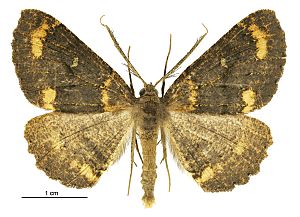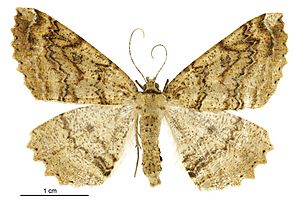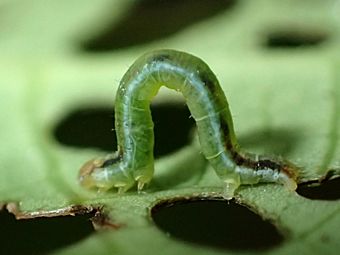Kawakawa looper moth facts for kids
Quick facts for kids Kawakawa looper moth |
|
|---|---|
 |
|
| Male | |
 |
|
| Female | |
| Scientific classification | |
| Synonyms | |
|
The kawakawa looper moth (Cleora scriptaria) is a special type of moth found only in New Zealand. It belongs to the Geometridae family, often called "looper moths" because of how their caterpillars move. This moth is well-known for feeding on the leaves of the kawakawa plant.
Contents
About the Kawakawa Looper Moth's Name
The kawakawa looper moth was first described in 1860 by a scientist named Francis Walker. He gave it the scientific name Tephrosia scriptaria at that time. Later, it was renamed Cleora scriptaria.
What the Kawakawa Looper Moth Looks Like
Adult kawakawa looper moths can look quite different from each other in terms of their color and size. Most often, their front wings are a mix of yellow and brown patterns. Some moths might have big yellow patches on darker wings.
Both male and female moths have unique spots in the middle of their wings. These spots can be black, white, or cream colored. You can tell males and females apart by their antennae. Males have feathery antennae, which are good for sensing things. Females have shorter, plain antennae.
When the moth is feeding, its antennae uncoil, which helps tell it apart from other moths. Adult moths are usually 10 to 15 millimeters (about 0.4 to 0.6 inches) long. Their wings can spread out to be 30 to 55 millimeters (about 1.2 to 2.2 inches) wide.
Young caterpillars are light green. As they get older, they change to a light brown color.
Where the Kawakawa Looper Moth Lives
Cleora scriptaria is found only in New Zealand. It is quite common across the country.
Kawakawa Looper Moth Habitat
Kawakawa looper moths are usually found near or on kawakawa plants. They also live on other plants they like to eat. Adult moths hide among fallen leaves or on tree trunks. Their patterned wings help them blend in, like camouflage.
Caterpillars are usually found on the leaves of plants. As they eat, they leave behind distinctive holes in the leaves.
Host Plants for Caterpillars
The caterpillars of this moth mostly eat the leaves of the kawakawa plant at night. This leaves a clear pattern of holes. They also feed on other plants like horopito (Pseudowintera species), wineberry/makomako (Aristotelia serrata), ramarama (Lophomyrtus species), and akeake (Dodonea viscosa). They can even eat leaves from introduced feijoa plants.
Kawakawa leaves have chemicals that usually stop insects from eating them. However, these chemicals do not stop the kawakawa looper caterpillars. Older caterpillars tend to make notches along the edges of the leaves.
Kawakawa Looper Moth Life Cycle
Adult Moths
When a kawakawa looper moth is fully grown, it has two pairs of wings and three pairs of legs. Its head has two long antennae and a long, coiled-up "snout" called a rostrum. The rostrum uncoils when the moth feeds on nectar from flowers.
Female moths that have just come out of their cocoons release special chemicals called pheromones. These pheromones attract male kawakawa looper moths. Male moths have special antennae with many sensory cells. These cells help them detect the female's pheromones from a distance.
Eggs and Caterpillars
Female kawakawa looper moths lay their eggs on the leaves or stems of their favorite host plants, usually the kawakawa plant. They lay eggs in groups of 3 to 12. The eggs are pale green and shaped like cylinders.
Once an egg develops, the caterpillar chews its way out. Young caterpillars are pale green with dark or white stripes along their sides. They usually stay on leaf veins or along the edges of leaves. They lie as flat as possible to blend in and hide.
As caterpillars grow, they shed their skin in a process called moulting. When they moult, they often change color. Older caterpillars might become pale brown. During the day, older caterpillars hide in plant crevices or between leaves.
Pupae
When a caterpillar is fully grown, it lowers itself to the ground. It then hides among leaf litter and tunnels into the top layer of soil. Here, the caterpillar moults again and changes into a pupa. The pupa is brown and has two thin parts at the end of its body called a cremaster. The cremaster helps the pupa attach itself to a twig or other structure.
When the moth is ready to come out, the pupa splits open. The new moth then climbs onto a branch or twig. It hangs there to expand its wings and let its body harden before it can fly.
Kawakawa Looper Moth Predators and Parasites
Parasites and Parasitoids
A tiny worm called a nematode can infect kawakawa looper caterpillars. There are also six known types of parasitoids that live inside the caterpillars and pupae. These parasitoids grow inside the caterpillar. When they are ready, they leave the caterpillar's body. They then attach themselves to a kawakawa leaf and spin a cocoon.
Predators
A type of bug called Cardiastethus consors has been seen eating the eggs and caterpillars of kawakawa loopers in labs. Birds, bats, spiders, and other insects that eat meat likely also hunt kawakawa loopers at all stages of their lives, even if it hasn't been officially recorded.
More About the Kawakawa Looper Moth
Kawakawa looper moths use their brown color and wavy wing edges to blend in. They look like tree bark or dead leaves, which helps them hide. When caterpillars are young, their green color helps them disappear among green kawakawa leaves. As they get older and turn brown, they blend in with twigs. This camouflage helps protect them from birds.
The kawakawa looper moth moves in a special way. It "loops" along surfaces by bringing its back end up towards its front legs. It uses its prolegs, which are fleshy legs found on some insect larvae but not on adult insects.
While the kawakawa looper moth itself doesn't have much cultural importance, its main host plant, kawakawa, is very important. Kawakawa is known as one of the most important herbs in traditional Maori medicine. The plant has properties that fight germs, so it is used to treat wounds, cuts, and some skin conditions.
Images for kids



